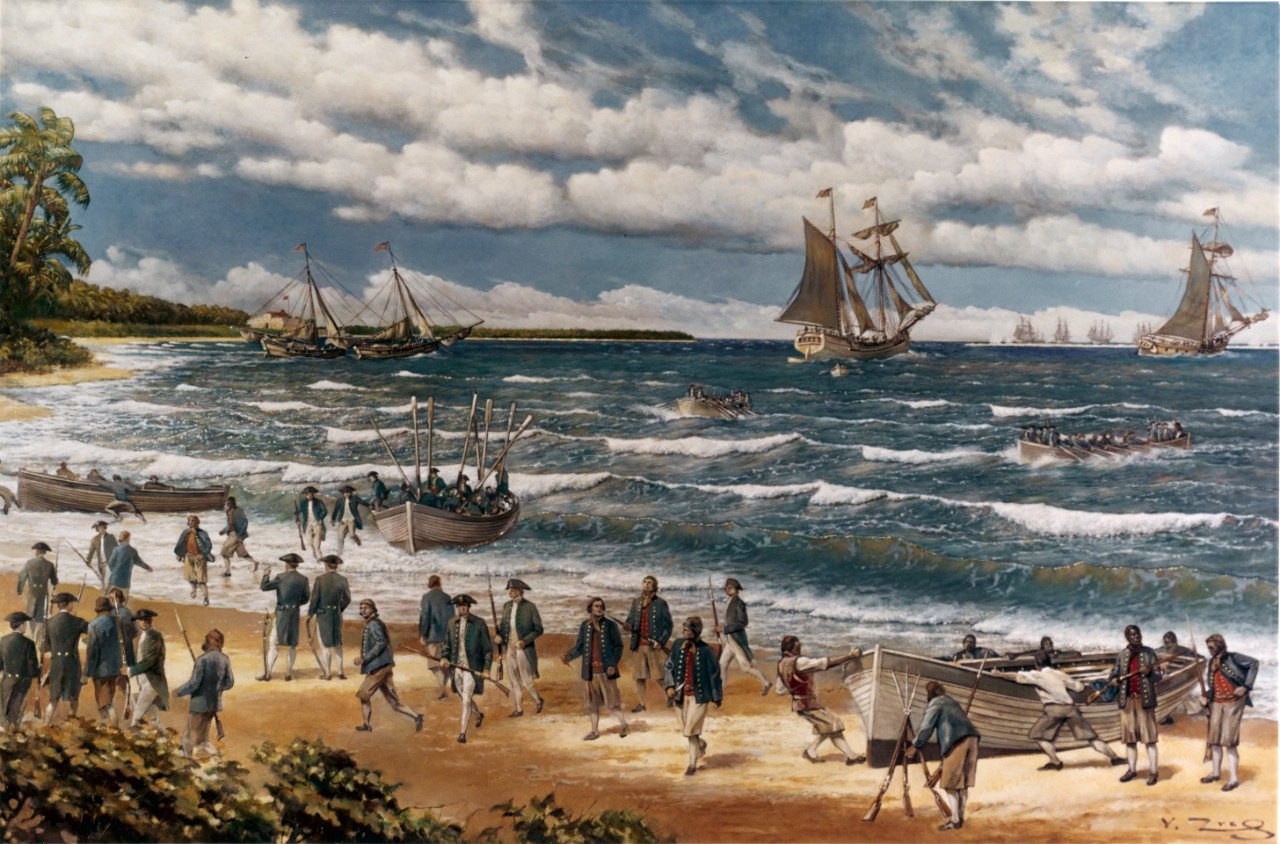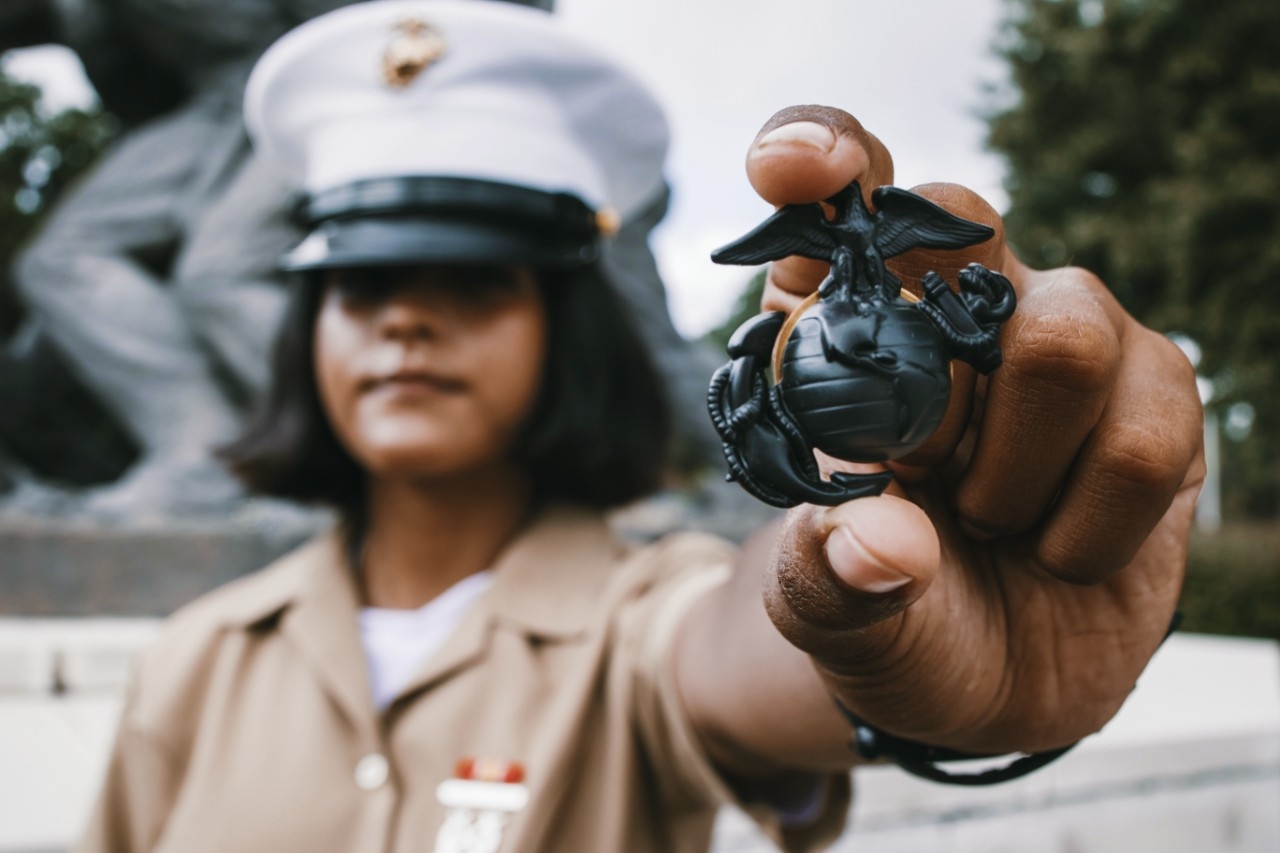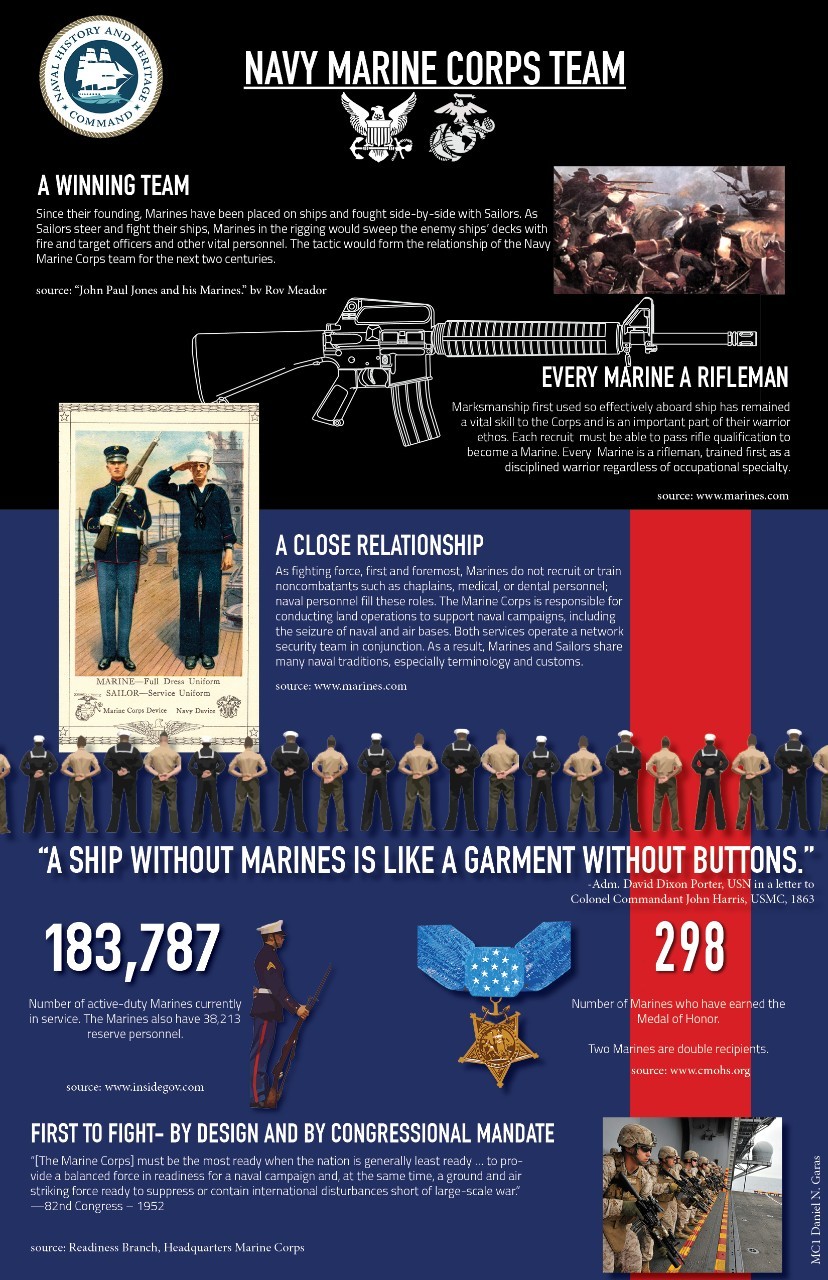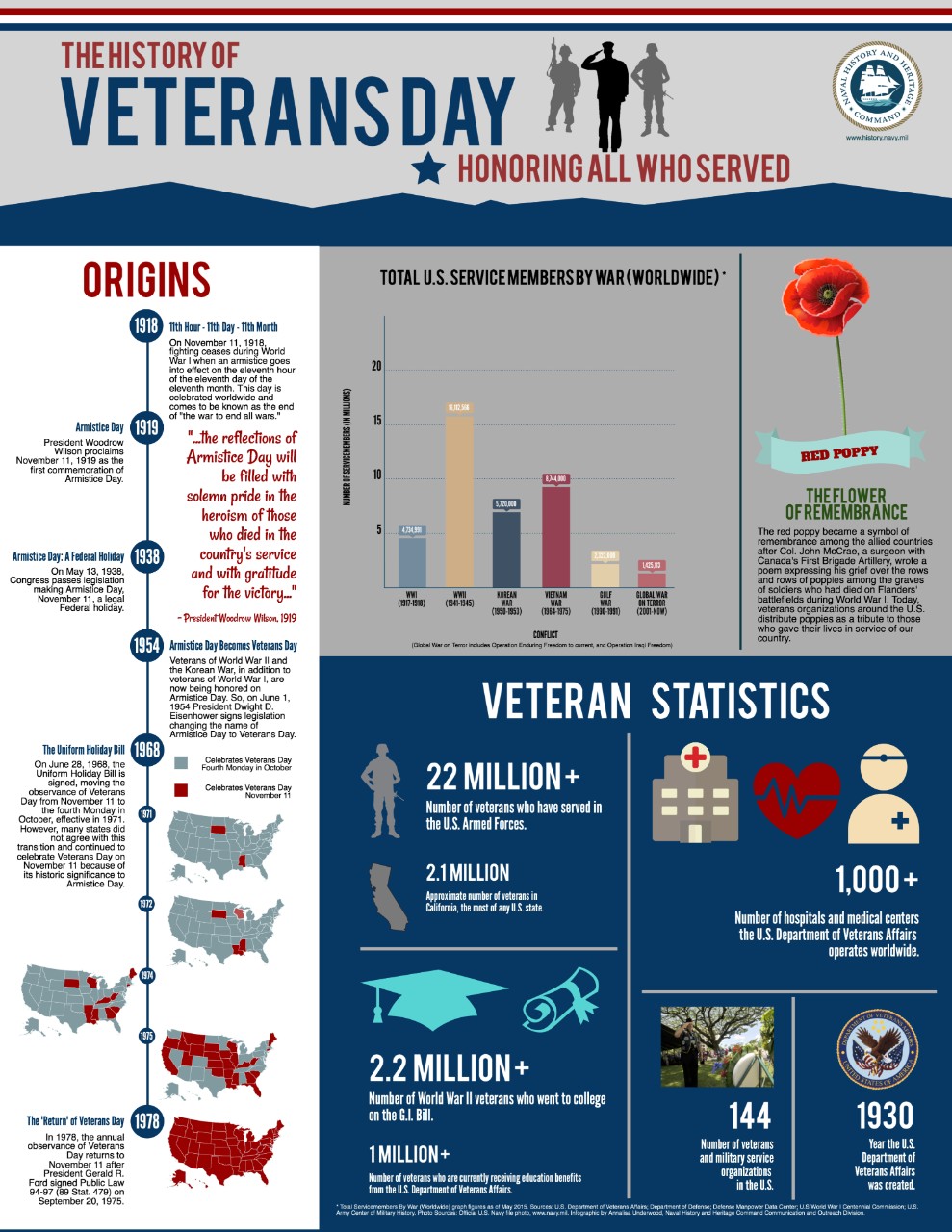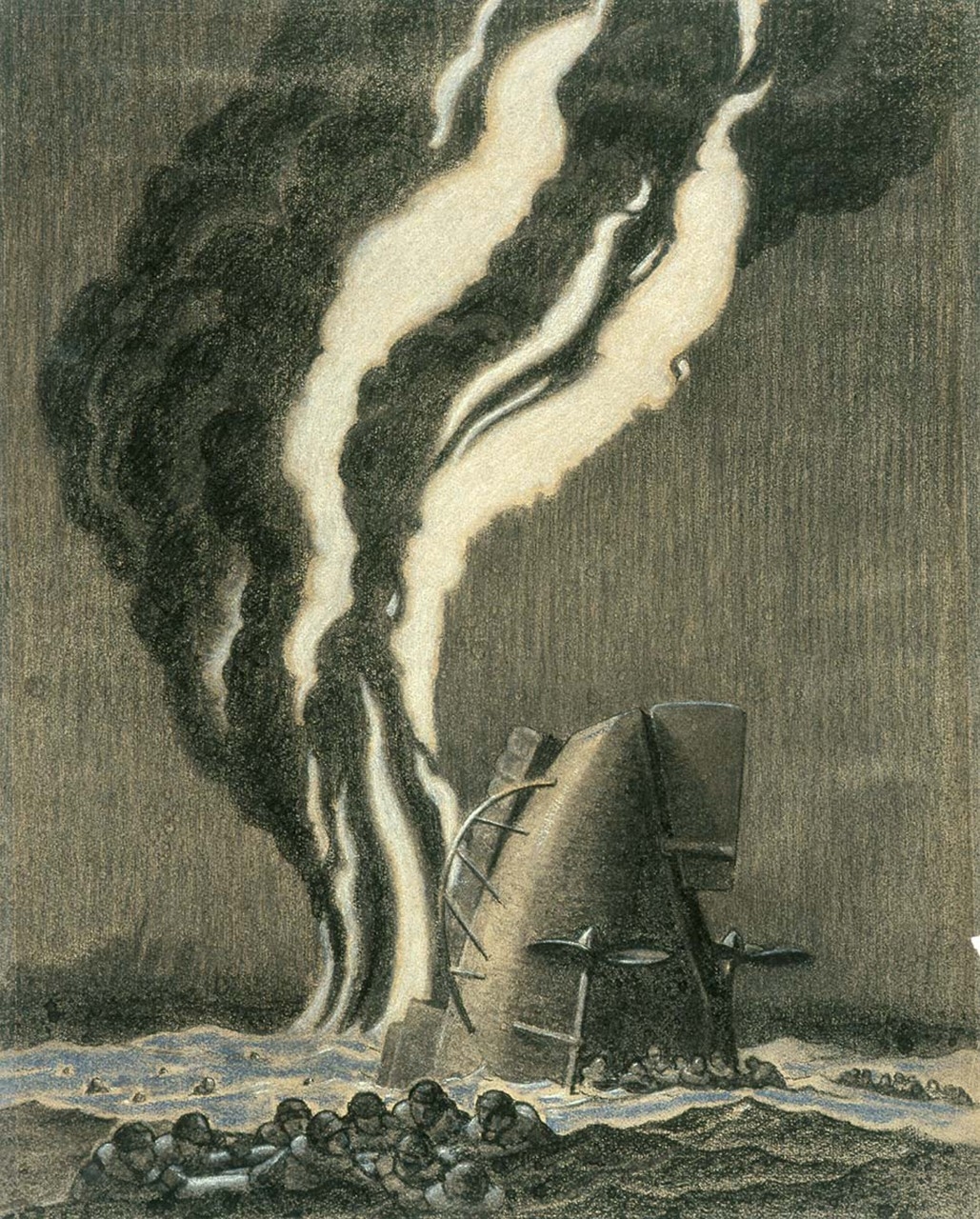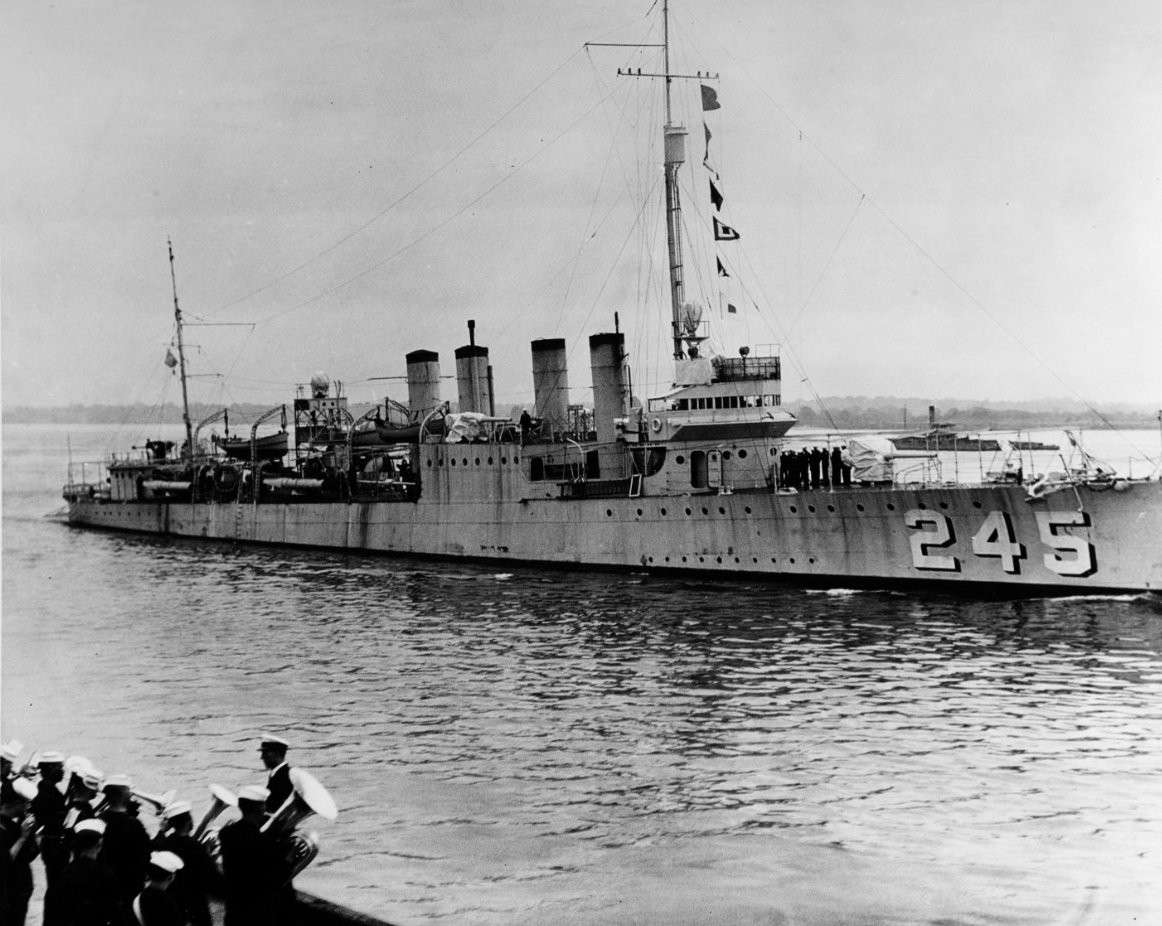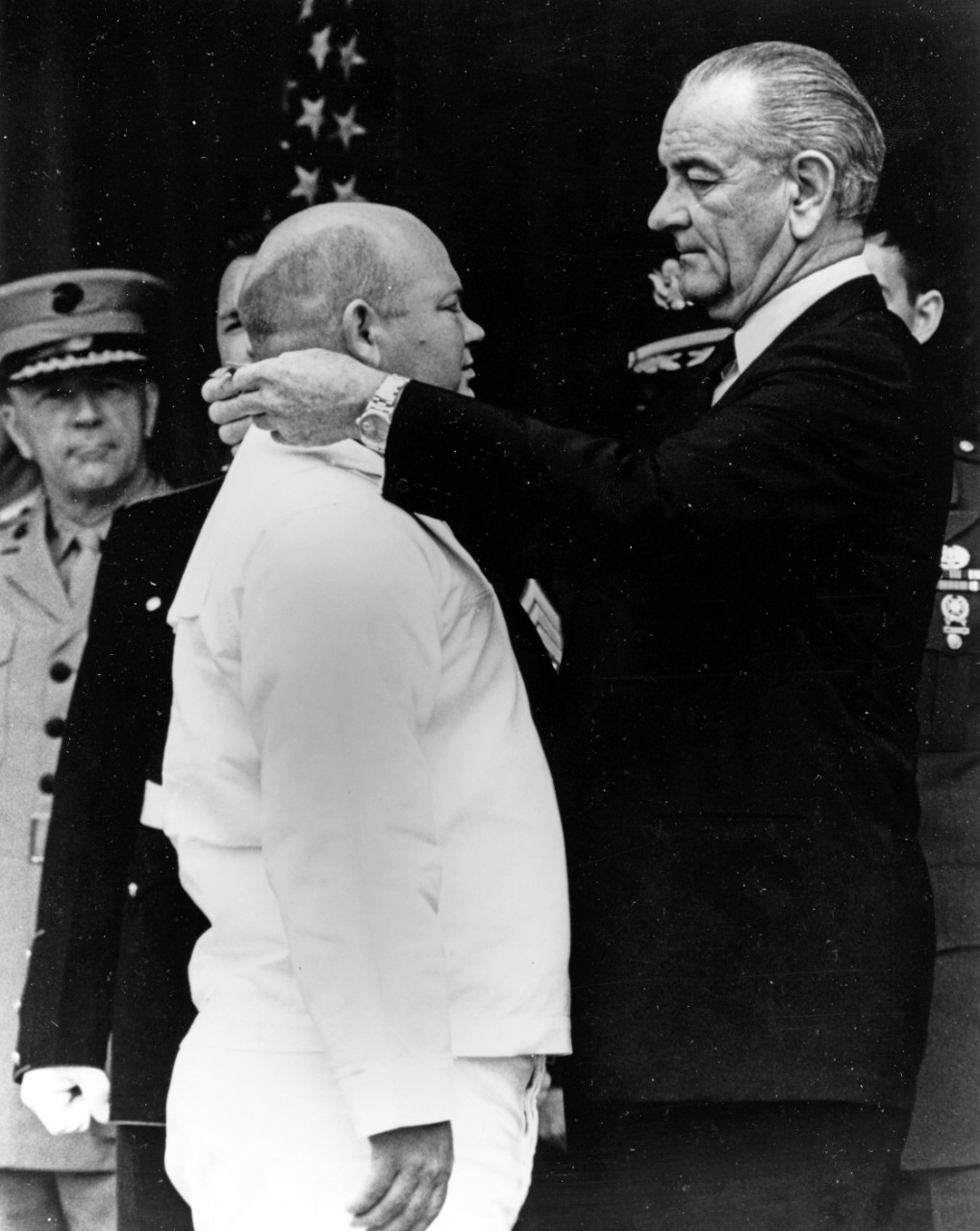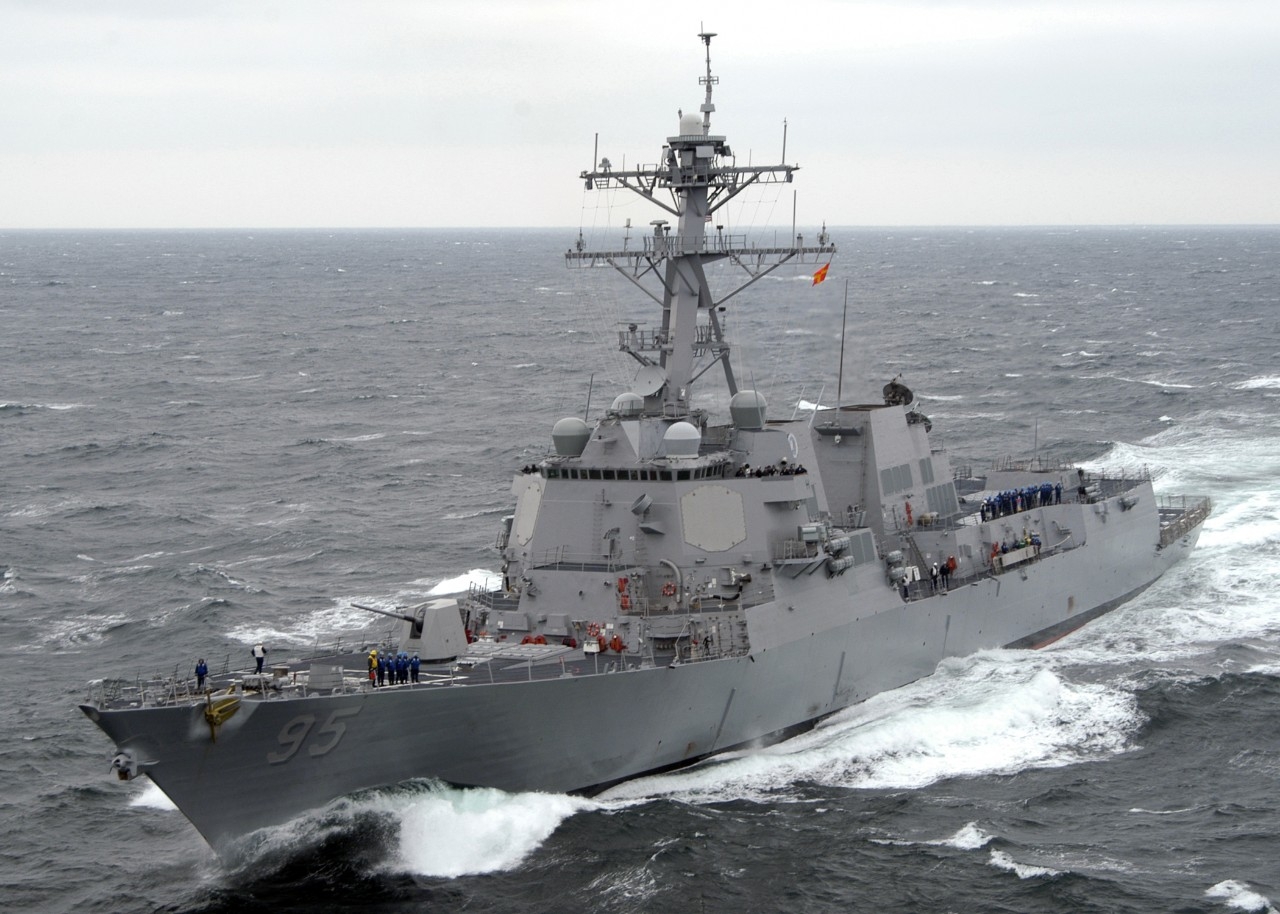Compiled by Brent A. Hunt, Naval History and Heritage Command’s Communication and Outreach Division
Happy Birthday, U.S. Marines!
On Nov. 10, 1775, the second Continental Congress met in Philadelphia and voted to raise two battalions of Marines for service as landing forces, thus establishing today’s U.S. Marine Corps. Under the command of Capt. Samuel Nicholas and serving on land and at sea, these first Marines distinguished themselves in a number of important operations that included their first amphibious assault, which took place in the Bahamas in March 1776. Nicholas was the first commissioned officer in the Continental Marines and remained the senior Marine throughout the American Revolution. After the war, the Continental Navy’s ships were sold, and the Marines were discharged.
The U.S. Navy was reestablished in 1794, and the Marines were subsequently reconstituted on July 11, 1798. During the Quasi-War with France, Marines landed on Santo Domingo and, between 1801 and 1805, took part in multiple operations against the Barbary pirates along the “shores of Tripoli.” During the War of 1812, Marines took part in the defense of Washington, DC, at Bladensburg, Maryland, and fought alongside Gen. Andrew Jackson in the defeat of the British at New Orleans. During the Mexican-American War, Marines seized seaports on both the Gulf and Pacific coasts of Mexico. A battalion of Marines joined Army Gen. Winfield Scott at Pueblo and fought all the way to the “halls of Montezuma” in Mexico City. During the Civil War, Marines took part in all of the U.S. Navy’s operations, including riverine warfare and amphibious landings. Marines continued to perform with valor during the Spanish-American War on operations in Cuba, Puerto Rico, Guam, and the Philippines.
In World War I, the Marine Corps distinguished itself on the battlefields of France. The 4th Marine Brigade earned the name “Devil Dogs” for its actions in 1918 during the pivotal Battle of Belleau Wood and during the final Meuse-Argonne offensive. Marine aviation also played a significant role in the war with bombing missions over German-occupied areas of France and Belgium. More than 30,000 Marines served during the war and roughly one-third of them were either killed or wounded. Fourteen Marines were awarded the Medal of Honor for their actions during World War I.
Prior to World War II, the Marines began to develop doctrine, equipment, and organization for amphibious landings. This effort proved successful first on Guadalcanal, then on Bougainville, Tarawa, New Britain, Kwajalein, Eniwetok, Saipan, Guam, Tinian, Peleliu, Iwo Jima, and Okinawa. By the end of the war, the Marine Corps had grown to six divisions, five air wings, and supporting troops. During World War II, 87,000 Marines were either killed or wounded. Eighty-three Marines were awarded the Medal of Honor.
In September 1950, Marines once again answered the nation’s call when North Korea invaded South Korea, launching the Korean War. They participated in the amphibious landings at Inchon, the recapture of Seoul, and the Battle of the Chosin Reservoir, which marked the beginning of hundreds of thousands of Chinese soldiers entering the war. After years of offensives, counteroffensives, endless trench warfare, and occupation duty, the last Marines were withdrawn from the Korean Peninsula in March 1955. More than 25,000 Marines were killed or wounded during the Korean conflict. Forty-two Marines were awarded the Medal of Honor.
The landing of the 9th Marine Expeditionary Brigade at Da Nang in 1965—the first deployment of a major U.S. ground combat unit to Vietnam— marked the beginning of large-scale American involvement in the Vietnam War. By the summer of 1968, after the enemy Tet Offensive, Marine strength peaked at approximately 85,000 boots on the ground. The Marines began to withdraw in 1969, when the South Vietnamese military began to play a larger role in the war. The last Marine ground forces left Vietnam in June 1971. As in previous conflicts, the Marines paid a heavy price. More than 13,000 were killed and another 88,000 wounded. In the spring of 1975, Marines participated in the evacuation of U.S. embassy staffs, American citizens, and refugees from Saigon, following the defeat of South Vietnam, and from Phnom Penh, Cambodia, after that country fell to communist Khmer Rouge forces. Fifty-eight Marines were awarded the Medal of Honor for their actions during the Vietnam War.
The mid-1970s saw the Marine Corps assume an increasingly significant role in defending NATO’s northern flank as amphibious units of the 2nd Marine Division participated in exercises throughout northern Europe. The 1980s brought an increased number of terrorist attacks on U.S. embassies around the world. Marines, under the direction of the State Department, continued to serve with distinction in their role as embassy guards. In August 1982, Marine units landed in Lebanon as part of the multinational peacekeeping force. For the next 17 months, Marines participated in various operations in an attempt to keep the peace and stabilize the country. Tragedy struck on Oct. 23, 1983, when two truck bombs struck separate buildings housing U.S. Marines and French forces at the Beirut International Airport, killing nearly 300 American and French service members. One of the trucks rammed through the gate at the entrance of the building housing 1st Battalion, 8th Marines, and the driver detonated the improvised bomb, killing 220 U.S. Marines, 18 Sailors, and three Soldiers. More than 100 were also injured in the attack. Later that month, Marines took part in the short-notice Operation Urgent Fury, the U.S. intervention in Grenada. In December 1989, Marines participated in Operation Just Cause, the U.S. invasion of Panama, undertaken to protect American lives and restore the democratic process in that country.
The next decade proved to be another demanding time in U.S. Marine Corps history. Between August 1990 and January 1991, 92,000 Marines deployed to the Persian Gulf in support of Operation Desert Shield/Storm in response to the Iraqi army’s invasion of Kuwait. The main attack came on Feb. 24 when the 1st and 2nd Marine Divisions breached Iraqi defense lines and stormed into Kuwait. By the morning of Feb. 28, 100 hours after the ground war began, almost the entire Iraqi army in the Kuwaiti theater of operations had been encircled, with 4,000 tanks destroyed and 42 divisions destroyed or rendered ineffective. Marines rounded out the decade with a humanitarian mission in Somalia, peacekeeping missions in Bosnia-Herzegovina and Kosovo, the restoration of democracy in Haiti, and the evacuation of American citizens in several African nations due to civil unrest.
In more recent events, Marines played a significant role in the Global War on Terrorism in the aftermath of the Sept. 11, 2001, terrorist attacks in New York and Washington, DC. Marines deployed to the Arabian Sea and in November set up a forward operating base in southern Afghanistan in support of Operation Enduring Freedom. Marines expanded their role in anti-terrorism activities with deployments to the Arabian Gulf, the Horn of Africa, and the Philippines. In 2003, the largest deployment of Marines since the Persian Gulf War occurred when 76,000 Marines deployed to the U.S. Central Command area of operations for combat operations in Iraq in support of Operation Iraqi Freedom.
Today, the Marine Corps continues to be ready to answer the nation’s call just as those who so valiantly fought at Belleau Wood, Iwo Jima, Chosin Reservoir, Khe Sanh, and Fallujah. Happy 248th birthday, U.S. Marines! For more on the Navy and Marine Corps Team, visit NHHC’s website.
Veterans Day
On the 11th hour of Nov. 11, 1918, fighting ceased when an armistice between Germany and the Allied nations came into effect, ending World War I. One year later, President Woodrow Wilson proclaimed Nov. 11 as the first commemoration of Armistice Day to honor World War I veterans. The first celebration using the term Veterans Day happened in Birmingham, Alabama, in 1947. Raymond Weeks, a World War II veteran, organized “National Veterans Day,” which included a parade and other festivities, to honor all veterans. The event was held on Nov. 11, then designated Armistice Day. Later, U.S. Representative Edward Rees of Kansas proposed a bill that would change Armistice Day to Veterans Day. In 1954, Congress passed the bill and President Dwight D. Eisenhower signed it, proclaiming Nov. 11 as Veterans Day. Weeks received the Presidential Citizens Medal from President Ronald Reagan in November 1982. Weeks’s local parade and ceremonies are now an annual event celebrated nationwide.
A law passed in 1968 changed the national commemoration of Veterans Day to the fourth Monday in October. It soon became apparent, however, that Nov. 11 was a date of historic significance to many Americans. Therefore, in 1978 Congress returned the observance to its traditional date.
Veterans Day is observed to honor military veterans and recognize the sacrifices that military veterans have made for this country. Today, more than 18 million veterans have proudly worn the uniform of the nation’s armed forces. Veterans Day provides Americans the opportunity to celebrate and honor America’s veterans for their patriotism, willingness to serve, and many sacrifices. For more, check out NHHC’s Resources for Veterans page, which provides links to a plethora of information, including guidance for those who are attempting to locate records related to their military service.
First U.S. Ship Lost during World War II
As it was escorting Convoy HX 156 near Iceland at approximately 5:34 a.m. on Oct. 31, 1941, USS Reuben James (DD-245) was hit on the port side by two torpedoes from German submarine U-562. Their explosions subsequently sank the destroyer, killing 100 of its crew. All seven of Reuben James’s officers, including 35-year old Lt. Cmdr. Heywood L. Edwards, the commanding officer, died as a result of the attack. Forty-four of the crew survived. Reuben James was the first U.S. ship lost to enemy action during World War II.
Named to honor Gunner’s Mate Reuben James, who participated with distinction in the Quasi-War with France, the Barbary Wars, and the War of 1812, the ship was commissioned on Sept. 24, 1920. On Oct. 21, 1921, Reuben James proceeded to Le Havre, France, where it joined USS Olympia (CL-15) for the Oct. 25 ceremony that marked the departure of the body of the Unknown Soldier from France for interment at Arlington National Cemetery. It then steamed for the Baltic, and at Danzig, Poland, (Oct. 29, 1921–Feb. 3, 1922), Reuben James provided assistance to the American Relief Administration in its efforts to relieve hunger and misery in the aftermath of World War I. After further duty in the Mediterranean, it departed Gibraltar on July 17, 1922, bound for New York. Reuben James’s activities assumed a pattern throughout the 1920s with active operations punctuated by port visits, overhauls, and repairs. As an example, Reuben James embarked members of the U.S. Naval Reserve’s 16th Division at Whitestone Landing, Long Island, New York, on July 3, 1926, and set course for Nantucket, Massachusetts, arriving on Independence Day. There, Reuben James’s baseball team played a local exhibition game. Sailing on July 6, the destroyer joined the Fourteenth Squadron, U.S. Scouting Fleet, in Napeague Bay, Long Island, and participated in exercises with other destroyers in the waters off Block Island and Newport, Rhode Island (July 7–16), interrupting the training with a weekend at Newport. Debarking the reservists back at Whitestone Landing on July 17, Reuben James steamed to the Philadelphia Navy Yard, where it served as an exhibition destroyer for the Navy at the Sesqui-Centennial Exposition (July 18–31). After an active decade, Reuben James was decommissioned at the Philadelphia Navy Yard on Jan. 20, 1931.
Recommissioned on March 9, 1932, Reuben James again operated in the Atlantic and Caribbean. From September 1933 to January 1934, it patrolled Cuban waters during a period of revolution. Steaming for the Pacific from Norfolk on Oct. 19, 1934, Reuben James arrived at its new homeport of San Diego, California, on Nov. 9. Reuben James operated off the West Coast for the next half decade, participating in regular training, periodic overhauls, upkeep, and port visits. It returned to the Atlantic Fleet in January 1939. Reuben James operated out of Philadelphia through that summer. Then, on Aug. 29, it reported for conversion to a small seaplane tender, AVP-16. However, on Sept. 1, hostilities began in Europe with the German invasion of Poland, and the conversion was canceled. Reuben James was subsequently assigned neutrality patrol and convoy escort duties, mostly in the Atlantic, Mediterranean, and off the U.S. eastern seaboard. The ship was lost two months later.
Today in Naval History—Most Decorated Enlisted Sailor in U.S. Navy History
On Oct. 31 1966, during the Vietnam War, Boatswain’s Mate First Class James E. Williams was assigned to the River Patrol Force, whose mission was to intercept enemy arms shipments on the waterways of South Vietnam. Williams, who was patrol commander for his boat, River Patrol Boat (PBR) 105, and another PBR, was searching for a Viet Cong force operating in an isolated area of the Mekong Delta. Suddenly, guerrillas in two high-speed sampans opened fire. Williams and his crew neutralized one boat crew, but the other escaped into a nearby canal. As they gave chase, the PBR Sailors soon found themselves in a beehive of enemy activity, in which Viet Cong guerrillas fired rocket- propelled grenades and small arms from fortified riverbank emplacements.
Against seemingly overwhelming odds, Williams led his PBRs against enemy junks and sampans while calling in naval aviation support. When UH-1B Huey helicopters from the Navy’s Helicopter Attack (Light) Squadron 3 arrived, he assisted in another attack that evening, turning on his boats’ searchlights so that the aircraft could easily identify and attack enemy forces, even though this action exposed him to fire. After the battle was complete, the American naval force had killed numerous Viet Cong guerrillas, destroyed more than 50 vessels, and disrupted a major Viet Cong logistical operation.
On May 14, 1968, President Lyndon B. Johnson presented Williams with the Medal of Honor for “his extraordinary heroism and exemplary fighting spirit in the face of grave risks [that] inspired the efforts of his men to defeat a larger enemy force, and are in keeping with the finest traditions of the U.S. Naval Service.”
In addition to the Medal of Honor, Williams received the following awards during a 20-year career that also included combat service during the Korean War: the Navy Cross, Silver Star (with one gold award star), the Legion of Merit (with “V” device), the Navy and Marine Corps Medal (with gold star), Bronze Star (with two gold stars), the Vietnam Cross of Gallantry (with gold star and palm), Navy Commendation Medal, Navy and Marine Corps Presidential Unit Citation (with one service star), Purple Heart (with two gold stars), Vietnam Service Medal (with bronze service star), Republic of Vietnam Campaign Medal, National Defense Service Medal (with bronze service star), United Nations Service Medal, Korean Service Medal (with two bronze service stars), Korean Presidential Unit Citation, Korean War Service Medal, and the Navy Good Conduct Medal (with four bronze service stars). Williams is considered the most decorated enlisted Sailor in U.S. Navy history.
After he retired from the Navy in 1967, Williams returned to his home state of South Carolina, where he found another way to serve his country. In 1969, he was appointed U.S. marshal for the District of South Carolina. In May 1977, he transferred to the Federal Law Enforcement Training Center in Glynco, Georgia, where he served as an instructor. He was called back to South Carolina in July 1979 under court appointment as U.S. marshal for South Carolina and served in that position until April 1980. He was then transferred to the U.S. Marshals Service Headquarters in Washington, DC, where he served until his retirement from federal service.
Williams passed away on Oct. 13, 1999, also the Navy’s birthday. He is buried at the Florence National Cemetery in South Carolina. Guided missile destroyer USS James E. Williams (DDG-95) is named in his honor. Williams’s Medal of Honor citation is prominently displayed on his namesake ship’s mess deck, providing Sailors a daily reminder of his legacy.

